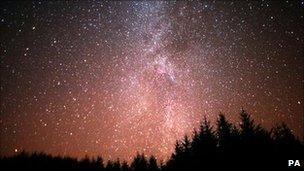Galloway Dark Sky Park 'helps insects' Buglife reports
- Published

Buglife say artificial light affects invertebrates such as bees, which play a part in pollinating plants
The UK's first Dark Sky Park has been held up as an example of how invertebrates could be protected from harm caused by artificial light.
Conservation group Buglife has highlighted Galloway Forest Park in the south of Scotland in a new report.
Buglife warned street lighting, man-made shiny surfaces and certain paint colours attracted insects away from flowers and natural egg-laying sites.
Galloway's reduced light pollution was recognised in 2009.
The International Dark Sky Association confirmed the forest park as one of the best places for stargazing in the world.
Lighting experts were brought in to ensure the skies above the woodland were pitch black at night.
Buglife mentioned the project among the recommendations in its new report A Review of the Impact of Artificial Light on Invertebrates.
The document's authors said: "Areas with natural or near-natural lighting regimes should be officially conserved.
"Additional Dark Sky Preserve areas should be identified to complement the Galloway Forest Park Dark Sky Preserve.
"In these areas existing light pollution should be reduced and strict limits and constraints placed on any new lighting."

Galloway Forest Park became a dark sky site in 2009
Buglife said many invertebrates, such as moths and glow worms, depended on the natural rhythms of day-night and seasonal and lunar changes to light levels.
However, artificial light could disrupt invertebrates' feeding, breeding and movement.
Buglife said bees, which play a key role in pollinating plants, could be drawn away from flowers by brightly coloured outdoor surfaces.
The report also said a rare beetle, the lesser silver water beetle, was attracted away from water to red coloured cars and would lay their eggs on them.
It added: "The coating of the eggs is acidic and eats away the surface of the car's paint."
In Scotland, Buglife's work has previously included highlighting discoveries of rare invertebrates.
In 2009, a tiny creature no bigger than 1mm in length found in the Scottish hills was confirmed as the first recorded member of its species found in the UK.
The springtail Bourletiella viridescens was photographed in the Cairngorms by Tim Ransom.
Previously, it was reported in literature as having been found at two sites in north England, but there are no specimens to back this.
Experts identified and confirmed the Highlands sighting.
- Published4 June 2010